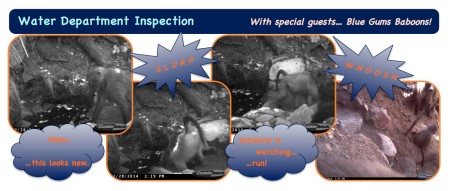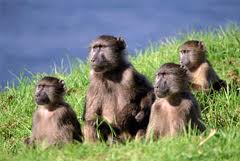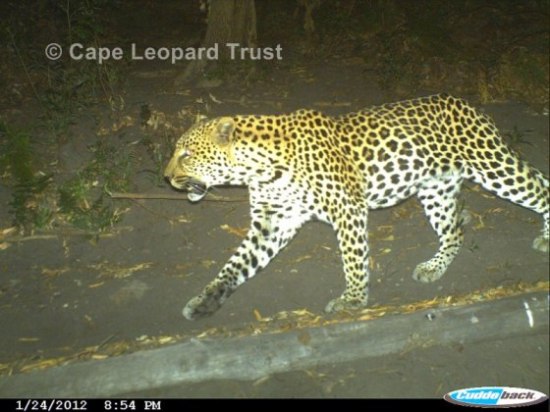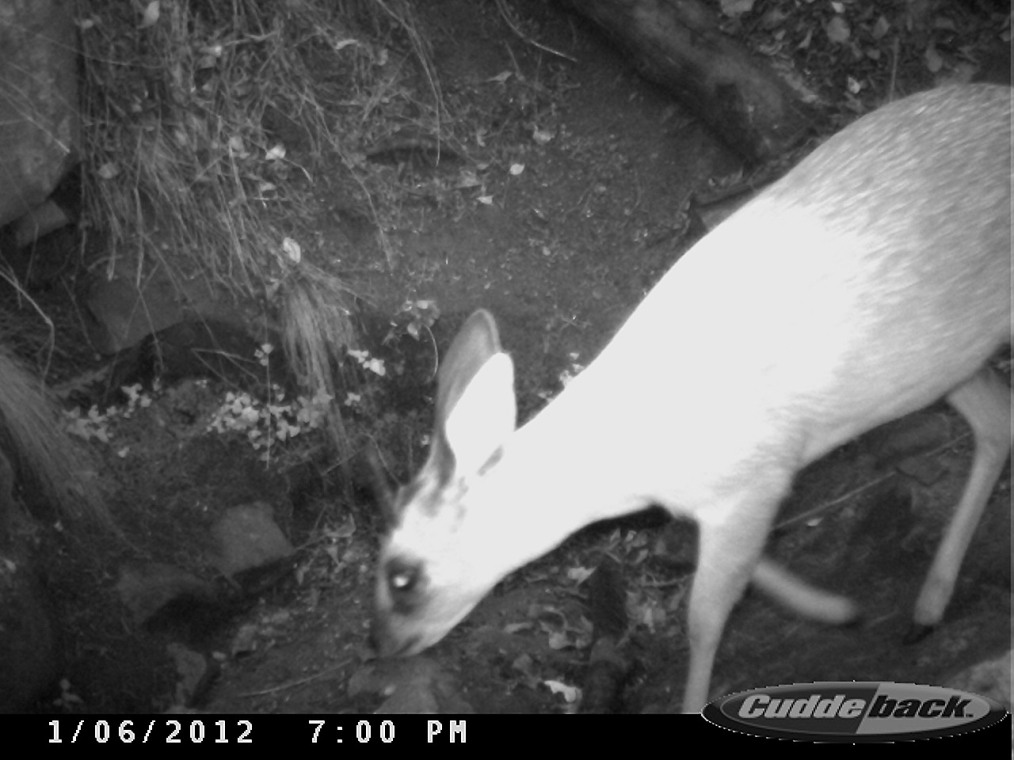“We have been living here for 10 years, and the baboons have only taken over the place on three separate days during all that time.”
That was Rosalind’s famous statement in 2009 in response to the perennial question we get about living at BlueGumsFree: “but how do you cope with the baboons?” Once or twice every fortnight the Miller’s Point troop roosts on the cliffs directly above BlueGumsFree about two hundred metres from the house.

Baboons near their roosting spot above BlueGumsFree
They have two trails from their roosting spot to the main road to Cape Point. One passes about twenty metres to the South of BlueGumsFree, the other one goes directly through our small plot of land.

Baboons Guiding Baboon-Monitors Along Cape Point Rd just Below Blue Gums
They make frequent attempts to raid our house and their arrivals and departures are times of action and excitement – for us, our dogs and the baboons. There are times when it can be annoying, and when they do manage to get past our defences it can be irritating and rather frightening. But for the most part they are a pleasure to have as neighbours. They are intelligent, engaging, and entertaining, with senses of perception that put our comparatively retarded eyesight, sense of smell and hearing to shame. Their agility and dexterity are a marvel to witness and their capacity to scale up sheer rock faces in the blink of an eye are a source of amazement and envy – especially for an ageing bipedal, who takes half-an-hour to cover the same distance that they traverse in minutes.
10 years or 3650 days, and while the baboons had been passing nuisances on a fairly regular basis, they had only caused serious problems on 3 separate occasions. That translates into 0,0003% of the time that we have been sharing their space. And by serious problems I mean taking over the house, running amok inside, ransacking foodstuffs and leaving a very unpleasant mess, but no injuries, no damage of any significance, no ugly confrontation. Even our dogs and the baboons have fine tuned their territorial battles into a well orchestrated choreography with each group of mammals respecting well defined boundaries. If the baboons come within metres of the house, the dogs see them off with a mixture of posturing and real aggression, but when the baboons cross invisible thresholds the engagement becomes a virtual pantomime of the ancient struggle between canids and primates, with the dogs walking a safe distance behind the troop and the baboons all but ignoring them unless they come too close until they are forced back with a bark, a rolling of the eyes and a dramatic flash of canines.

“Force”, now condemned to die, notices the dogs have gone for a walk and tries to pay a visit,but the door is locked and baboon proof, so a raid becomes a photo opportunity.
This amicable co-existence continues for the most part, but since 2009 things have taken a turn for the worse. This minor but noticeable downturn in relationships between ourselves and the baboons can be traced to their rigorous exclusion from their foraging grounds north of Millers Point, thereby dramatically reducing their range, and to the awarding of contracts (for whatever reasons) to baboon monitoring groups besides Baboon Matters.
Why has this happened?
Well for a start it has happened because the challenge of baboon co-existence with humans on the Peninsula has been reduced to an issue to be addressed by science and bureaucracy in their most negative forms: science as theory based on induction, and bureaucracy as a blind adherence to rules even if they inhibit actions designed to achieve the desired goals.
Why were we able to develop a life of co-existence with the baboons and why has this balance been disrupted in the last 3 years? I think it is because we were able to find a blend of deterrence and tolerance. The baboons and ourselves worked it out in practice. The baboons learnt that we would not tolerate their invasion into our space and that barking dogs, loud noises and assertive behaviour would, for the most part, enforce a respect for boundaries. And at the same time a tolerance on our part for their presence whenever they were not presenting any threat (which was most of the time) meant that they discovered where they could go about their daily lives in peace.
This began to change when baboon monitors, operating under the instructions of experts, began to hassle and harass the animals in order to keep them away from the main road, from restaurants and from built up areas. Not only did this force them into smaller spaces, with fewer targets for high calorie food, but it inured them from the deterrents that worked so well in the past.
And as some of the baboons become bolder and unafraid, they sign their own death warrants and sooner or later are shot by the authorities operating under the direction of the experts. And then they blame the activists who have tried to develop strategies and solutions that are contextually specific and seek a more nuanced solution. And so the blame goes on and on. The scientists blame the baboon activists. The activists blame the scientists. It’s not like either one of them has done much good for the baboons whose fate appears to be sealed one way or another. But it is rich indeed when a Professor of Anthropology from UC San Diego can say: “The epitaph of these baboons will read: ‘Met an untimely end because activists could not face reality’’.

‘Fred’ at Castle Rock. He has already met an untimely end.
When the crags above Blue Gums Free fall silent; when the rising sun is no longer greeted by the barking of the waking baboons; when there are no more youngsters carousing on the cliffs, it won’t be Baboon Matters, but those who chose to respond to this challenge by shooting the likes of Fred (with Merlin and Force soon to follow) who will earn the curses of Blue Gummers both past and present. And you can be pretty sure that Jane Eliza will curse louder than the rest of us. She lived here on this mountain with the baboons for over thirty years and although she fired her shotgun in anger on the odd occasion it was always to deter and never to kill.

Two Adult Males Above BlueGumsFree


















